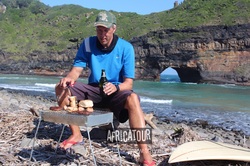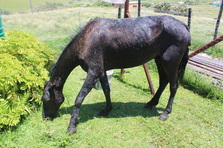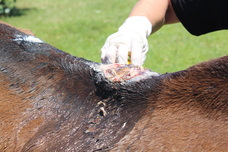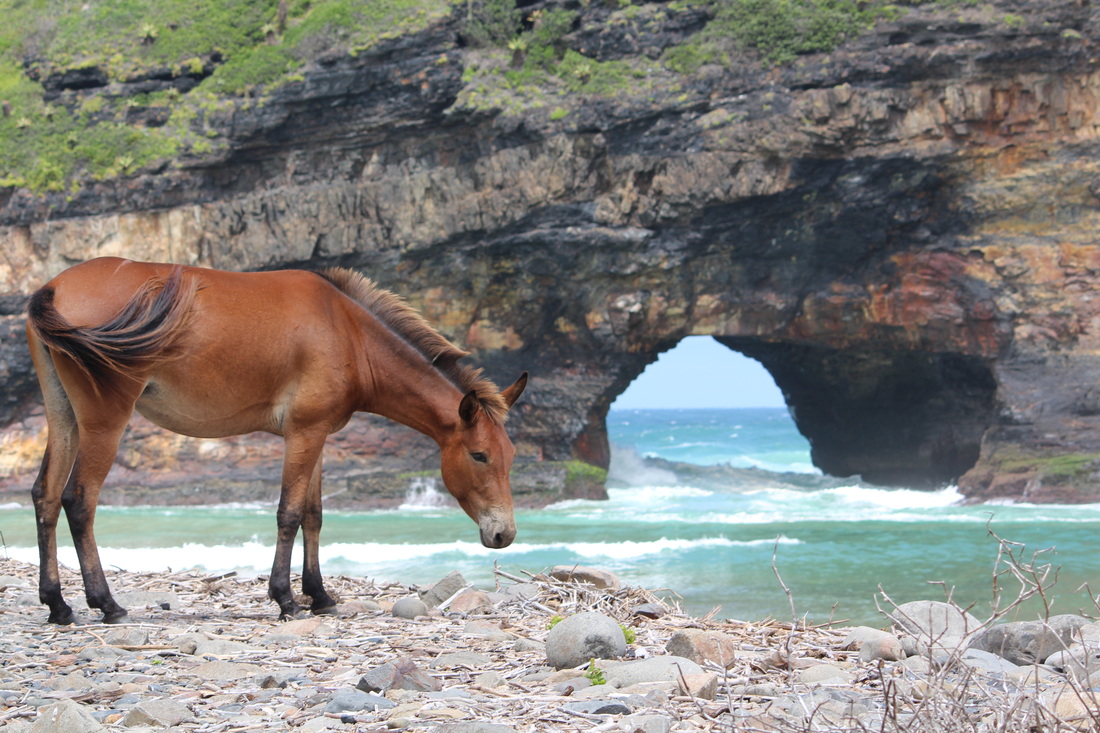|
The pain is searing as it lances up my leg and explodes through my entire body like the blazing sun. I slow in an attempt to reduce it as the hill rises relentlessly before me. Yet immediately a sharp pain burns across my side as he brings down the thin stick. I have no energy. I feel weak. I want to stop. I remember a time when I lived in a warm place, where I was brushed every day. There was a time when I was fed sweet apples and would trot around a ring, where I would jump and people would cheer. A time when my hair was soft, as was the touch of those who cared for me. The whip strikes me again, this time curling around and cutting me beneath my stomach. The fiery burn sears. The pain of the whip is matched by the pain of my sore leg. Yet, if I continue, at least the pain of the whip will leave me. I move on, limping to try and stop the lancing pain. I know this route, this hill. It is only the first of many, and this journey will take several hours. The whip comes down again. I shudder but I move forward…

As a family of five traveling for a year through southern Africa we are blessed to see some of the most incredible sights possible. The beauty is beyond words – a huge walking grey giant, gently caring for its small calf with a tenderness that belies the power of the elephant – a waterfall that plunges into the ocean that is unknown to the modern world – a majestic hole in a huge mountain dropped in the middle of the sea. These and many other sights are the weave of wonder that forms the beauty of South Africa. Yet our journey is not just about relishing this beauty, it’s also about meeting the locals who live in these “wish you were here” spots, who are truly making a difference, and who in many ways are the true beauty of this land.
Too often as tourists we arrive, grab the glossy brochure, book on the organized event, enjoy the 10am scones and rest by the pool waiting for dinner. I will be the first to admit – I love the glossy brochure, as it gives us great ideas of what to do - I enjoy organized events, especially a seafood braai – and as for the 10am scones, we are not missing that! Arriving at Hole in the Wall hotel after a long and bouncy ride along the 18km rutted dirt road – which is actually a paved freeway compared to the potholed road prior to it – we dive fully into tourist mode. The 10am teatime treat is a real winner; we even have to race back from an early morning hike to be there in time for this. The seafood braai is fantastic – there is nothing quite like eating mussels, prawns and fresh fish while watching the waves roll in across a tranquil sea. 
The main reason, however, for being at Hole in the Wall is the stunning backdrop of the Hole in the Wall beach. Huge waves surge proudly towards a towering mountain that seems to have grown out of the sea, only to be dispatched with little regard for their foaming fury. A small section of the wave explodes through the hole and reforms into a perfect wave that rises and travels on towards the river that enters the sea at this picturesque point. The girls are surfing, as this is the spot made famous by the movie Blue Crush 2, and reenacting those surf scenes is a must on every young surfer girl’s agenda.

For me, I’m relishing one of the best braai spots in the world. Nothing beats braaing with this spectacular backdrop, a beer in hand, and the smell of wors mixing with the salty sea spray rising tantalizingly into the air. Days can easily be spent lazing on the beach, surfing, braaing, walking the stunning hills, or even negotiating the not-for-CLKs road to Coffee Bay. This is the ideal spot to just get away from it all.
“I love it here,” Mervin, one of the hotel guests says to us, as we meet him while loading our plate with fresh scones. "I have been here for nearly a week and I have not driven once in my car," he explains. That’s what Hole in the Wall is all about – arrive and enjoy until you leave. However if this is only what we do we are missing out on some of the most amazing wonders of the area. I am not referring to the Hole in the Wall, or the mini Hole in the Wall, or any of the other incredible view sights or hikes. I’m referring to a woman who is one of the most amazing natural wonders of the area – Marlene.
“Hi Marlene, I am not sure how we can help but I would love to bring our family to come and see you and your work,” reads the Facebook message I send Marlene. And so it is on Friday morning…just after morning tea (of course)…we jump into our Pajero and bounce the 1 kilometer route to Marlene’s home. We are greeted at the small white home, overlooking the aqua blue sea below, with an enthusiastic rendition of “who the hell are you” by her eager family of dogs.
“Dad, I hope you told her we don’t really know much about horses,” my children had said earlier that morning. And of course they are right – we really don’t know much about horses. However one of our goals on this trip is not just to travel but also to be touched by the lives of others, and to help touch their lives in whatever way we can. In order to do that we will have to go outside of what we “know” or what we are comfortable with. So it is with a little trepidation that we arrive at the Hole in the Wall horse project to meet Marlene. “Hi Craig,” nice to meet you Marlene says after the enthusiastic cacophony has been stilled. Introductions are made and Marlene is quick to introduce us to her latest two patients, as she refers to the horses she cares for. The time for our lesson, our huge lesson on compassion, cruelty and kindness begins.
The sight is heart wrenching. I've never seen a horse in this condition. It's hair is thin and covered in an oily-like grime. Thousands of ticks, gorged on blood, cling to nearly every part of its emasciated body. It limps painfully on a damged rear leg, making it difficult for it to even move a few steps. It's ears droop. Yet it's none of these that strikes at my heart - it's the look in her eyes. I've never seen such sadness in an animal's eyes. I've never seen such resignation, such pain. I've never seen an animal cry - as a tear rolls down its cheek from its large plaintive eyes, and my daughter attempts to dab it away.
"They rode her here all the way from Coffee Bay?" Marlene informs us. There are tears in her eyes. Her compassion is so visceral, it’s almost as if she is one with the horse and its pain. The route from Coffee Bay to hole in the wall is an arduous 9km route on a rutted, uneven road. The road rises and falls hundreds of meters as it winds over hills and through valleys. "They rode her, in this condition, with her lame leg all that way. And they were planning on riding her back. I refused. I would not let them." She dabs her eyes with the back of her hand as she steps away.

"I'm shaking," Marlene says as she attempts to insert a needle into a vein in the horse's neck. Blood runs down its neck and across Marlene's hand. She pulls away and composes herself. Once more with shaking hands she inserts the needle. This time it's right and the pain medication flows into the horse as she empties the syringe.
"We will try and wash her," Marlene says, "I'm not sure how she will react as she has probably never been washed." Slowly and carefully we rub her oily, thin coat with a medicated soap wash. The horse does not react at all. She simply stands there, favoring her hurt leg and looking at us with sad eyes. We try to remove some of the thousands of ticks as we gently wash her. She just looks at us with those sad eyes. 
“Where do all these horses come from?” I ask looking at several horses and mules roaming freely on the hills behind her home. “Do they belong to someone?” Without stopping her gentle, caressing washing she replies, “They all belong to someone. There are people who go and buy ex-race horses and show jumping horses, and then they come and sell them to the locals here for a profit. Some of these may well be those horses. However they do not know how to survive in these conditions. They can’t adapt to the grass as their sole form of nutrition. Quickly they get thin and sickly.” She pauses for a moment as if considering how it is possible that people could ever do this to their animal. “I wonder if those people know what has become of their horses? I wonder if they care?” she says as love and compassion flow from her hands. “How did you ever get like this?” she whispers quietly to the horse.
"Let's allow her to dry in the sun now," Marlene says after we've rinsed the horse. "What should we name her?" she asks. "How about Marmite," Nicky, my wife suggests. The name is perfect - her brown-black, sticky hair looks like marmite. Yet it's more than that. A name somehow imbues her with a little more worth, with a sense of belonging. While she still has those sad eyes she somehow stands a little straighter. She somehow seems to know that she is being loved, as she, for the first time since we have been here, stoops down to eat some grass. 
"How long have you been doing this?" I ask. "For about three years. I was not trained for this," Marlene replies. "I just saw so many horses in such a terrible condition, I just couldn't ignore it. I had to do something, anything."
Nearby in Marlene's small garden another horse is grazing. It has a large, raw wound on its back caused by a saddle. It makes me feel slightly sick just to look at it. "I often start retching when I have to treat the horses,” Marlene says. “Time and again I have to walk away and compose myself. But I tell myself to stop being ridiculous, to pull it together, and I try again and again until I get it done. If I don't help them, who will?”
Outside her garden a horse comes to graze. It walks into a small enclosed paddock that has an open gate and drinks from the water. Several cows also graze contently just outside her fence. They feel it, they know it, this is a place of love. Something many of them, like most living things, are desperately in need of. This is a place were tears are shed, not just in sadness, but in joy, not just in pain but in thanks - for here exists some of the most beautiful wonders you can ever see – compassion, determination and love.
Marlene runs the Hole in the Wall Horse project. Please visit this link to find out more about her and this amazing project and how you can help her with this work. Even if all you do is share her story, you can help her make a difference to the lives of so many helpless animals. Click Share below to help share the word about Marlene and her work.
Comments
|
Archives
May 2017
Categories
All
|





 RSS Feed
RSS Feed
